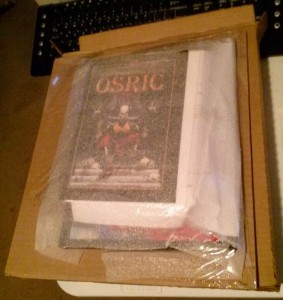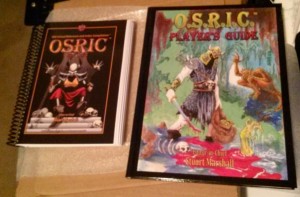My OSRIC Print order was waiting for me when I got home from work tonight.
As I posted earlier, I ordered the hard cover Player’s Guide and the softcover A5 lay flat full rules. My plan was to have them in time for Marmalade Dog, when I will be running Village of Hommlet as part of the OSR track.
As usual, from my prior order of Delving Deeper from Lulu, it was packed firmly to avoid damage from movement. There was a ding on one corner of the box, but no damage to either volume.
The hard cover is the 1st edition of OSRIC, and the lay flat is the 2nd edition. I am not aware of what the differences are, but a quick glance shows the Player’s Guide to be very thorough.
The Player’s Guide is a bit over 1/4 inch narrower, and maybe 1/8 inch shorter than the original AD&D Player’s Handbook. The AD&D Player’s Handbook clocks in at 126 pages, not counting the ad for GenCon and other TSR games. The OSRIC Player’s Guide has 170 numbered pages, plus the OSRIC Open License, Open Game License, spell index, index, and closing full page illustration.
Many of the illustrations pay homage to the original artwork. I like the one with the fighter and magic user in chains with a rat walking away, and the fighter says, “It didn’t work.”
The index has its own bit of humor. Under I it has “Is Anyone Reading This” on page “No”.
I like that all the bits and pieces for each attribute, race, and class are kept together. The organisation of OSRIC is one thing that is a big selling point. I did find it a little different trying to find spells by level, since they are in their alphabetically. I’ve gotten so used to go to spells of a certain level and then searching alphabetically, that it is a challenge. The benefit of having all the spells of the same level together is that it facilitates moving characters up through the levels to new spells.
For a new hardcover book, it lays open without effort or having to use the old school exercise for new books. The print is clear and legible and the paper seems heavy enough to take a lot of use.
The only quality issues with the Player’s guide is that some of the last few pages of the book were not separated at one small area at the top of the page. They all separated easily when using gentle effort. Also the fold on the top upper left and right corners of the front and back cover does not look like the illustration got folder over quite as neatly as it should have. None of this is anything I am worried about. There is no obvious issue with the text or the printing, other than what would be found with a full read through. This will be a game table resource, so minor flaws I can live with.
The lay flat of the full rules clocks in at 396 numbered pages which includes all the way through the index. The last two pages are the OSRIC Open License and the Open Game License. The AD&D Player’s Handbook (126 numbered pages), Monster Manual (112 numbered pages including the GenCon ad and other TSR games) , and Dungeon Master’s Guide (232 numbered pages), clock in at 470 pages. I am sure someone has done a comparison of what is different. I know in part that the differences is partly not using the same text as the original, since it is re-worded. Also a cleaner organization can eliminate a lot.
The lay flat is smaller in width and height. Each page is slightly wider and slightly shorter than a standard letter size (8.5″ x 11″) folded in half. With the spiral binding, it is about two inches wider than a letter sized page in landscape.
I find that the print is clean and easy to read, but small, which is a necessity to get so much on a small page. This is probably not an issue for younger eyes, but older eyes requiring bifocals need to be aware of the angles one tries to read it while lying flat. The amount of light on the page will also affect how easily one can read it. I have had thick glasses for nearsightedness since I was 13, but bifocals only the last 6 or 7 years. I find that for me, the angle and the lighting on the page are the biggest factor. I suppose if I keep gaming for a few more decades, I may need the large print version of the lay flat. Do they make one of those?
As with the Player’s Guide, the information is grouped more logically. Also the age generation method is in the player’s section. It optionally lists the height and weight tables. Secondary Skills are missing as are psionics. We rarely used psionics back in the day, but the secondary skill table gave an added bit of flavor. But it’s OK to make up your own rules. I take ideas from other games and other DM’s & campaigns all the time. Make it work the way you and your players like. If you’re not having fun, you’re doing it wrong.
Here are the pictures of the unboxing.





